+ Open data
Open data
- Basic information
Basic information
| Entry | Database: PDB / ID: 1xsd | ||||||
|---|---|---|---|---|---|---|---|
| Title | Crystal structure of the BlaI repressor in complex with DNA | ||||||
 Components Components |
| ||||||
 Keywords Keywords | TRANSCRIPTION/DNA / winged helix protein / TRANSCRIPTION-DNA COMPLEX | ||||||
| Function / homology |  Function and homology information Function and homology informationregulation of gene expression / response to antibiotic / negative regulation of DNA-templated transcription / DNA binding / cytoplasm Similarity search - Function | ||||||
| Biological species |  | ||||||
| Method |  X-RAY DIFFRACTION / X-RAY DIFFRACTION /  SYNCHROTRON / SYNCHROTRON /  MOLECULAR REPLACEMENT / Resolution: 2.7 Å MOLECULAR REPLACEMENT / Resolution: 2.7 Å | ||||||
 Authors Authors | Safo, M.K. / Ko, T.-P. / Musayev, F.N. / Zhao, Q. / Robinson, H. / Scarsdale, N. / Wang, A.H.-J. / Archer, G.L. | ||||||
 Citation Citation |  Journal: J.Bacteriol. / Year: 2005 Journal: J.Bacteriol. / Year: 2005Title: Crystal structures of the BlaI repressor from Staphylococcus aureus and its complex with DNA: insights into transcriptional regulation of the bla and mec operons Authors: Safo, M.K. / Zhao, Q. / Ko, T.-P. / Musayev, F.N. / Robinson, H. / Scarsdale, N. / Wang, A.H.-J. / Archer, G.L. | ||||||
| History |
|
- Structure visualization
Structure visualization
| Structure viewer | Molecule:  Molmil Molmil Jmol/JSmol Jmol/JSmol |
|---|
- Downloads & links
Downloads & links
- Download
Download
| PDBx/mmCIF format |  1xsd.cif.gz 1xsd.cif.gz | 56.1 KB | Display |  PDBx/mmCIF format PDBx/mmCIF format |
|---|---|---|---|---|
| PDB format |  pdb1xsd.ent.gz pdb1xsd.ent.gz | 37.4 KB | Display |  PDB format PDB format |
| PDBx/mmJSON format |  1xsd.json.gz 1xsd.json.gz | Tree view |  PDBx/mmJSON format PDBx/mmJSON format | |
| Others |  Other downloads Other downloads |
-Validation report
| Summary document |  1xsd_validation.pdf.gz 1xsd_validation.pdf.gz | 430.2 KB | Display |  wwPDB validaton report wwPDB validaton report |
|---|---|---|---|---|
| Full document |  1xsd_full_validation.pdf.gz 1xsd_full_validation.pdf.gz | 435.4 KB | Display | |
| Data in XML |  1xsd_validation.xml.gz 1xsd_validation.xml.gz | 10.6 KB | Display | |
| Data in CIF |  1xsd_validation.cif.gz 1xsd_validation.cif.gz | 14.8 KB | Display | |
| Arichive directory |  https://data.pdbj.org/pub/pdb/validation_reports/xs/1xsd https://data.pdbj.org/pub/pdb/validation_reports/xs/1xsd ftp://data.pdbj.org/pub/pdb/validation_reports/xs/1xsd ftp://data.pdbj.org/pub/pdb/validation_reports/xs/1xsd | HTTPS FTP |
-Related structure data
| Related structure data | 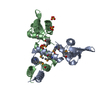 1sd4C  1sd6C  1sd7C  1okrS C: citing same article ( S: Starting model for refinement |
|---|---|
| Similar structure data |
- Links
Links
- Assembly
Assembly
| Deposited unit | 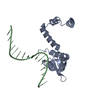
| ||||||||||||||||||
|---|---|---|---|---|---|---|---|---|---|---|---|---|---|---|---|---|---|---|---|
| 1 | 
| ||||||||||||||||||
| Unit cell |
| ||||||||||||||||||
| Components on special symmetry positions |
| ||||||||||||||||||
| Details | the second part of the dimer is generated by the two-fold symmetry operator of (-x, -y, z) |
- Components
Components
| #1: DNA chain | Mass: 4896.216 Da / Num. of mol.: 1 / Source method: obtained synthetically |
|---|---|
| #2: Protein | Mass: 14988.363 Da / Num. of mol.: 1 Source method: isolated from a genetically manipulated source Source: (gene. exp.)   |
| #3: Water | ChemComp-HOH / |
-Experimental details
-Experiment
| Experiment | Method:  X-RAY DIFFRACTION / Number of used crystals: 1 X-RAY DIFFRACTION / Number of used crystals: 1 |
|---|
- Sample preparation
Sample preparation
| Crystal | Density Matthews: 4.3 Å3/Da / Density % sol: 71.5 % |
|---|---|
| Crystal grow | Temperature: 298 K / Method: vapor diffusion, hanging drop / pH: 7.5 Details: PEG 8000, ethylene glycol, magnesium chloride, sodium HEPES, potasssium phosphate, pH 7.5, VAPOR DIFFUSION, HANGING DROP, temperature 298K |
-Data collection
| Diffraction | Mean temperature: 100 K |
|---|---|
| Diffraction source | Source:  SYNCHROTRON / Site: SYNCHROTRON / Site:  NSLS NSLS  / Beamline: X12C / Wavelength: 1.1 Å / Beamline: X12C / Wavelength: 1.1 Å |
| Detector | Type: CUSTOM-MADE / Detector: CCD / Date: Feb 5, 2004 |
| Radiation | Monochromator: CHANNEL-CUT SI CRYSTAL / Protocol: SINGLE WAVELENGTH / Monochromatic (M) / Laue (L): M / Scattering type: x-ray |
| Radiation wavelength | Wavelength: 1.1 Å / Relative weight: 1 |
| Reflection | Resolution: 2.7→30 Å / Num. all: 9291 / Num. obs: 9285 / % possible obs: 99.9 % / Observed criterion σ(F): 0 / Observed criterion σ(I): 0 / Redundancy: 13.7 % / Rmerge(I) obs: 0.065 / Net I/σ(I): 44 |
| Reflection shell | Resolution: 2.7→2.8 Å / Redundancy: 11.8 % / Rmerge(I) obs: 0.546 / Mean I/σ(I) obs: 4.5 / Num. unique all: 901 / % possible all: 99.8 |
- Processing
Processing
| Software |
| |||||||||||||||||||||||||
|---|---|---|---|---|---|---|---|---|---|---|---|---|---|---|---|---|---|---|---|---|---|---|---|---|---|---|
| Refinement | Method to determine structure:  MOLECULAR REPLACEMENT MOLECULAR REPLACEMENTStarting model: PDB entry 1OKR Resolution: 2.7→30 Å / Cross valid method: THROUGHOUT / σ(F): 0 / Stereochemistry target values: Engh & Huber Details: The 16 nucleotide DNA model in this structure represents an average of the 32 base-pair DNA used in crystallization. (Used the 32 base-pair DNA of 5'-GACTACATTTGTAGTATATTACAAATGTAGTA-3' and ...Details: The 16 nucleotide DNA model in this structure represents an average of the 32 base-pair DNA used in crystallization. (Used the 32 base-pair DNA of 5'-GACTACATTTGTAGTATATTACAAATGTAGTA-3' and 5'-TACTACATTTGTAATATACTACAAATGTAGTC-3') It contains phosphate groups at both 5' and 3' ends. There are a number of wide solvent channels in this crystal. In the void volume between the protein-DNA complex molecules some spiral densities are modeled as strings of water molecules. These are possibly a result of residuals of the averaged model of the DNA. It is also possible that this void volume may host some DNA molecules with low occupancies.
| |||||||||||||||||||||||||
| Refine analyze |
| |||||||||||||||||||||||||
| Refinement step | Cycle: LAST / Resolution: 2.7→30 Å
| |||||||||||||||||||||||||
| Refine LS restraints |
| |||||||||||||||||||||||||
| LS refinement shell | Resolution: 2.7→2.8 Å
|
 Movie
Movie Controller
Controller




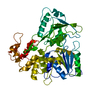
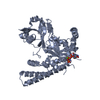
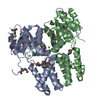
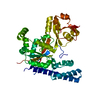
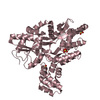
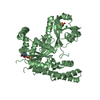

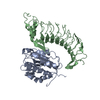

 PDBj
PDBj







































